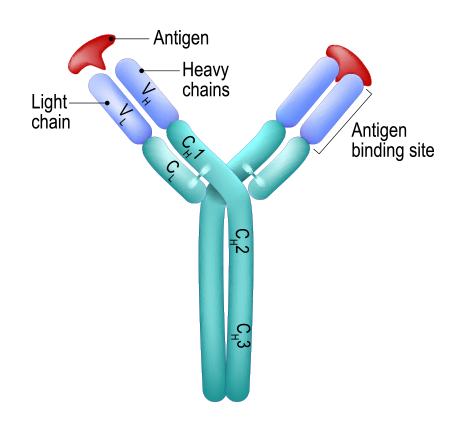IgG is a monomer composed of two heavy chains and two light chains of κ or λ.
It constitutes about 75% of the antibodies and is involved in neutralization, sedimentation and aggregation of toxins.

antibody data
About Antibody
antibody data - SKAI
Structure and types
of antibodies protecting our bodies
of antibodies protecting our bodies
Scripps Korea
Antibody Institute
- What is Antibody?
-
Our body can always recognize any strange molecules (antigens) because about 1 billion lymphocytes is constantly circulating in our body.
First, T lymphocytes can be classified into Killer T cell which is responsible for Cell-mediated Immunity by killing infected cells directly, and Regulatory T cell which regulates immune activity, Helper T cell that helps to secrete antibodies. Helper T cell plays a very important role in antibody production among them. Activated Helper T cell secretes cytokines to differentiate B lymphocytes into plasma cell and memory cell, where differentiated plasma cell produces antibody.
The produced antibodies bind specifically to antigens to protect our bodies by causing an antigen-antibody interaction, which is called Humoral Immunity.

- Antibody structure
-
The antibody consists of several polypeptide chains, two long chains and two short chains are joined and form a Y-shaped molecule.
It has a specific structure that can bind to antigens in the top two of Y.
This specific structure has unimaginable number of cases by gene rearrangement of DNA that occurs in immune cells, so it can respond to various antigens.
- Antibody isotypes
-
Antibodies are divided into five classes according to the amino acid sequence of heavy chains:
IgG (Immunoglobulin G) / IgM (Immunoglobulin M) / IgA (Immunoglobulin A) / IgD (Immunoglobulin D) / IgE (Immunoglobulin E).
-

-
 The IgM molecule has ten heavy chains and light chains, as the basic structure of the five monomers consists of a circular array.
The IgM molecule has ten heavy chains and light chains, as the basic structure of the five monomers consists of a circular array.
It is the first antibody to appear when the antigen enters, and it presents in the serum of the spinal animal.
It is because of IgM that aggregation occurs when different blood types are mixed in ABO blood type. -
 IgA is present with two immunoglobulins attached, and it is found in the inner wall of the digestive canal or saliva such as respiratory mucus, saliva or tears, and is involved in infection defense on the mucosal surface.
IgA is present with two immunoglobulins attached, and it is found in the inner wall of the digestive canal or saliva such as respiratory mucus, saliva or tears, and is involved in infection defense on the mucosal surface.
The IgA concentration in various body fluids (such as the synovial fluid, spinal fluid, cerebrospinal fluid, ocular humor, etc.) is about 1/6 of IgG, but in secretion fluids (such as colostrum, respiratory mucus, intestinal mucus, saliva, etc.) it has much higher concentration than IgG or IgM, so it acts as the first line of defense against microbial invasion in the secreted fluid. -
 IgD is a newly discovered immunoglobulin by discovering myeloma proteins in 1965. IgD also consists of two heavy chains and two light chains and it has fast coagulation rate and easily alter biological activity and structure.
IgD is a newly discovered immunoglobulin by discovering myeloma proteins in 1965. IgD also consists of two heavy chains and two light chains and it has fast coagulation rate and easily alter biological activity and structure.
It has been less known about the function of IgD, but it is known that it acts as a membrane receptor and involved in B cell maturation. -
 IgE exists as a monomer and consists of two heavy chains and two light chains.
IgE exists as a monomer and consists of two heavy chains and two light chains.
It exists the least in our body because it is bound to the cell membrane of certain cells, and is involved in allergic asthma, most adrenal infections, and allergic disease treatment.
